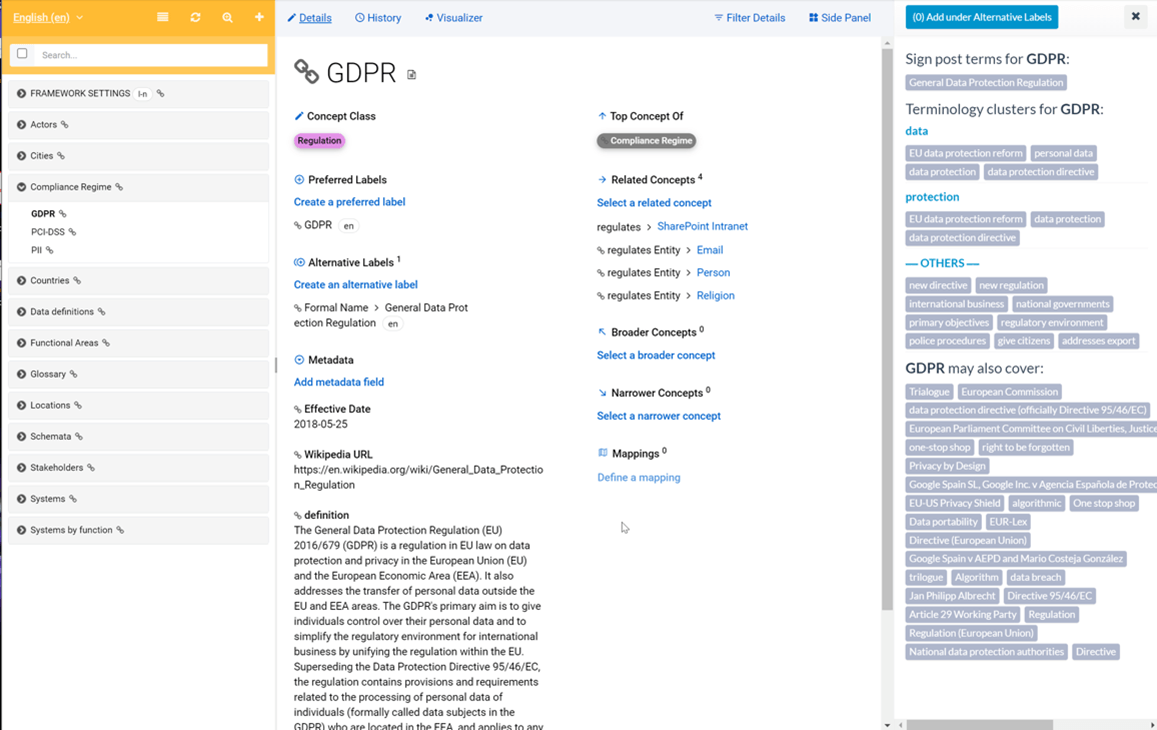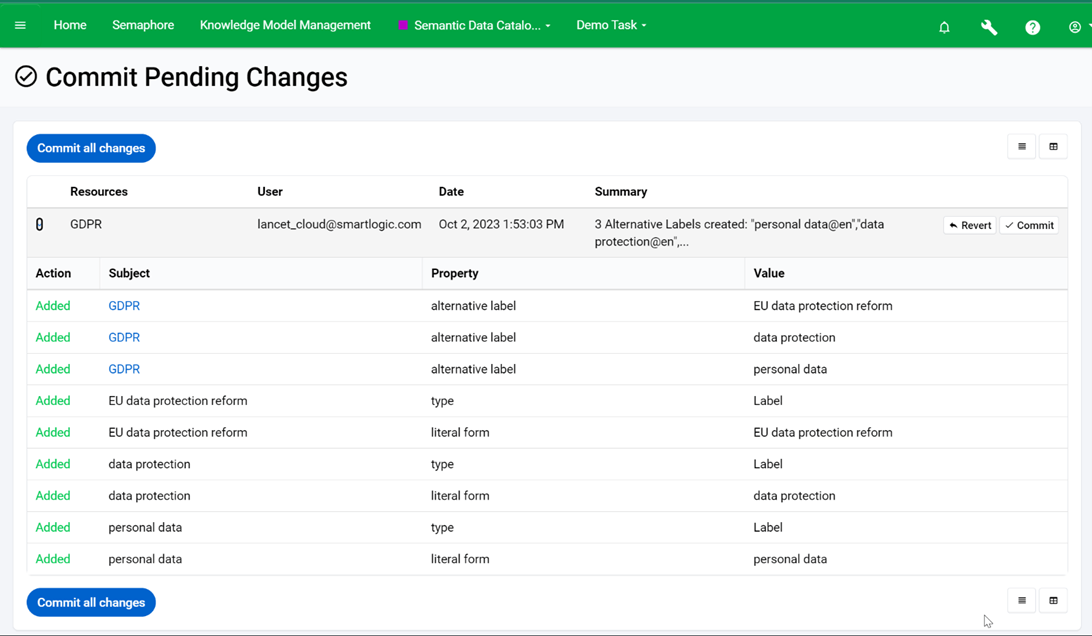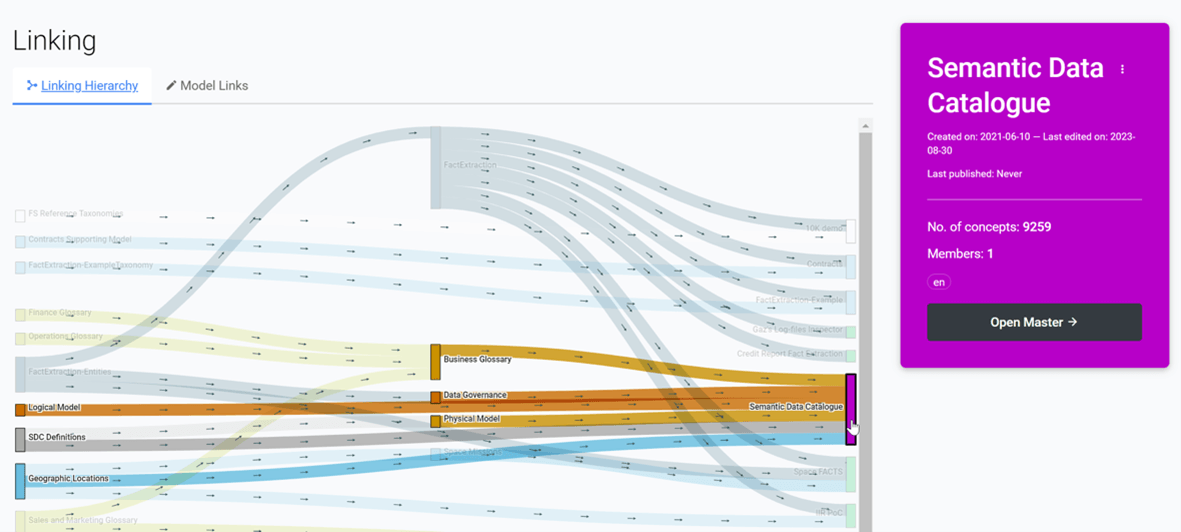D
Doug Dunn
Guest
Generative AI models can empower organizations to create, enrich and manage semantic models efficiently—unlocking valuable insights from their data. Embrace the power of generative AI and Semaphore to streamline your knowledge modeling journey and unlock the full potential of your data.
In the era of information expansion, making sense of data and extracting meaningful insights has become increasingly challenging for all organizations. Semantic Knowledge Models, which help organize and understand data by capturing its relationships and meaning and applying context to the data, have emerged as a crucial tool. However, for those new to semantic modeling, the challenge of getting started with building and maintaining models that encompass your domain of knowledge can seem quite daunting. Here, we will uncover how generative AI and Semaphore offer a solution to this challenge.
Semantic models serve as the backbone for organizing data and making it comprehensible to users. These models transcend traditional data structures, providing a framework for capturing the semantics and relationships inherent in data. They are pivotal in data integration, knowledge sharing and informed decision-making.
Semantic models find their application across all industries, in domains where data is vast, intricate and vital, such as e-commerce, privacy and customer experience. For example, a semantic model for records management in healthcare can help integrate patient records, medical research findings and clinical guidelines—facilitating improved patient care and groundbreaking research discoveries.
However, building semantic models from scratch can be a daunting task. It encompasses things like concept extraction, ontology development, query construction, data integration and quality control. This is where generative AI and Semaphore come in.
Generative AI, powered by advanced language models like GPT-4, can be a valuable tool for initiating the creation of semantic models. Here's how it can assist:
Let's consider an example in the healthcare domain. Suppose you're building a semantic model for patient records. Generative AI can analyze medical documents, identify critical medical concepts and help construct queries to retrieve patient data based on specific criteria, such as diagnoses or treatment outcomes.
Improving your semantic model involves enhancing its depth and breadth. Generative AI can be your partner in this journey:
Continuing with our healthcare example, let’s say you've built a semantic model for patient records, but it's essential to keep it up to date. Generative AI can help by continuously monitoring medical literature, identifying new treatments or guidelines and suggesting updates to your enterprise knowledge graph.
Once you've created and enriched your semantic model, efficient management is necessary to keep it updated and valid. Generative AI can facilitate this process in the following ways:
For instance, you've built a semantic model to manage product information in a corporate setting. Generative AI can automatically generate documentation for the model's attributes and relationships, making it easier for product managers and marketers to understand and utilize the model effectively.
While generative AI can assist with many aspects of semantic modeling, some tasks require specific expertise, such as creating SPARQL queries and SHACL shapes.
SPARQL (pronounced "sparkle") is a semantic query language that can retrieve and manipulate data stored in Resource Description Framework (RDF) format. Shapes Constraint Language (SHACL) is a standard language for describing Resource Description Framework (RDF) graphs. SHACL has been designed to enhance the semantic and technical interoperability layers of ontologies expressed as RDF graphs. These tools are powerful but can be difficult for non-technical users. Generative AI can bridge the gap.
As powerful as these generative AI tools are, they don’t come close to providing a comprehensive business-ready solution. Semaphore, an enterprise-class semantic AI, can take the modeling and query writing inputs from generative AI, enrich them and put them to work for your business case. Here are a few ways that Semaphore can take your generative AI output to the next level:
1. Enrich Knowledge Models: Semaphore offers enrichment side panel tools, such as label translations, new alternative label (synonyms) suggestions, text analytics, Wikipedia search and custom enrichment tools you can create. Along with the side panel tools, Semaphore enriches your data by providing classes, hierarchical and associative relationships and custom descriptive metadata fields.

Figure 1: Detailed view of the concept “GDPR” and suggested synonyms.
2. Model and Knowledge Governance: Semaphore allows you to apply your organization's development, testing, decommissioning and release processes to your knowledge models as well as SHACL and other constraints.

Figure 2: Changes to the concept "GDPR" awaiting approval to commit to production.
3. Linking Models from Different Knowledge Domains: Semaphore seamlessly links models from different knowledge domains, allowing organizations to gain cross-domain insights and connections.

Figure 3: Model linkage visualization showing the sources of the model "Semantic Data Catalog."
4. Query, Export, Report: Semaphore reporting tools can save, edit and reuse your SPARQL queries or SHACL Shapes.

Figure 4: Semaphore's Reporting Console
5. Putting Your Models to Work with Semantic Metadata: Semaphore employs a powerful classification service that generates semantic metadata, making it easier for organizations to extract valuable information and insights from their models. Semaphore's Semantic Enhancement Service allows your enterprise to access the powerful enterprise knowledge graph that the generative AI and Semaphore created together.
Generative AI and Semaphore form a dynamic duo, simplifying the creation and management of semantic knowledge models. In the age of data abundance, these tools offer a faster path to extracting meaningful insights from data.
Register for the upcoming webinar, Leveraging Generative AI to Jump Start Your Semantic Knowledge Modeling, to explore more in-depth examples of how generative AI and Semaphore deliver better overall results and make you much more productive in the creation, enrichment and management of your semantic models.
Register for the webinar
Continue reading...
In the era of information expansion, making sense of data and extracting meaningful insights has become increasingly challenging for all organizations. Semantic Knowledge Models, which help organize and understand data by capturing its relationships and meaning and applying context to the data, have emerged as a crucial tool. However, for those new to semantic modeling, the challenge of getting started with building and maintaining models that encompass your domain of knowledge can seem quite daunting. Here, we will uncover how generative AI and Semaphore offer a solution to this challenge.
Semantic Models: The Backbone of Data Understanding
Semantic models serve as the backbone for organizing data and making it comprehensible to users. These models transcend traditional data structures, providing a framework for capturing the semantics and relationships inherent in data. They are pivotal in data integration, knowledge sharing and informed decision-making.
Semantic models find their application across all industries, in domains where data is vast, intricate and vital, such as e-commerce, privacy and customer experience. For example, a semantic model for records management in healthcare can help integrate patient records, medical research findings and clinical guidelines—facilitating improved patient care and groundbreaking research discoveries.
However, building semantic models from scratch can be a daunting task. It encompasses things like concept extraction, ontology development, query construction, data integration and quality control. This is where generative AI and Semaphore come in.
Creating Semantic Models with Generative AI
Generative AI, powered by advanced language models like GPT-4, can be a valuable tool for initiating the creation of semantic models. Here's how it can assist:
- Concept Extraction: Generative AI can analyze your unstructured text data and extract key concepts, helping you build a foundational knowledge base for your semantic model. It identifies essential terms and their relationships by ingesting a corpus of textual information.
- Ontology Development: Formulating a well-structured ontology is fundamental to creating a semantic model. Generative AI can help with this process by suggesting concepts, hierarchies and relationships based on discussions and textual information related to your domain.
Let's consider an example in the healthcare domain. Suppose you're building a semantic model for patient records. Generative AI can analyze medical documents, identify critical medical concepts and help construct queries to retrieve patient data based on specific criteria, such as diagnoses or treatment outcomes.
Enriching Semantic Models with Generative AI
Improving your semantic model involves enhancing its depth and breadth. Generative AI can be your partner in this journey:
- Data Integration: Many organizations have diverse data sources, making integration challenging. Generative AI can identify common semantic elements in different data sources and suggest mappings or alignment strategies, thus ensuring harmonized data.
- Knowledge Graph Enrichment: Building out your enterprise knowledge graph with additional information, such as new nodes, edges or attributes, is crucial. Generative AI can analyze textual data and suggest relevant additions to enhance your knowledge graph.
- Quality Control: Maintaining data quality is paramount. Generative AI can help you automate quality control checks and identify inconsistencies, redundancies or errors that have crept into your semantic model.
Continuing with our healthcare example, let’s say you've built a semantic model for patient records, but it's essential to keep it up to date. Generative AI can help by continuously monitoring medical literature, identifying new treatments or guidelines and suggesting updates to your enterprise knowledge graph.
Managing Semantic Models with Generative AI
Once you've created and enriched your semantic model, efficient management is necessary to keep it updated and valid. Generative AI can facilitate this process in the following ways:
- Documentation and Explanation: Documenting your semantic model and explaining its components are vital for collaboration and understanding. Generative AI can generate detailed documentation and explanations to promote easy usage.
- Content Summarization: Managing vast amounts of textual content relevant to your semantic model can be challenging. Generative AI can help summarize this content, extracting key insights and concepts for inclusion in your model.
For instance, you've built a semantic model to manage product information in a corporate setting. Generative AI can automatically generate documentation for the model's attributes and relationships, making it easier for product managers and marketers to understand and utilize the model effectively.
Adding the Power of SPARQL and SHACL
While generative AI can assist with many aspects of semantic modeling, some tasks require specific expertise, such as creating SPARQL queries and SHACL shapes.
SPARQL (pronounced "sparkle") is a semantic query language that can retrieve and manipulate data stored in Resource Description Framework (RDF) format. Shapes Constraint Language (SHACL) is a standard language for describing Resource Description Framework (RDF) graphs. SHACL has been designed to enhance the semantic and technical interoperability layers of ontologies expressed as RDF graphs. These tools are powerful but can be difficult for non-technical users. Generative AI can bridge the gap.
How Generative AI Helps with SPARQL and SHACL
- Query Generation: SPARQL query generation can be complex, especially when dealing with large and complex RDF datasets. Generative AI can assist in generating SPARQL queries by providing query templates and enabling natural language to SPARQL conversion.
- Query Optimization: Generative AI can assist in optimizing your SPARQL queries by suggesting query modifications or reordering operations to improve performance.
- SHACL Shape Generation: SHACL shapes validate RDF data against predefined constraints. Generative AI can help in SHACL shape generation by analyzing existing data, providing shape templates and suggesting validation rules based on your requirements.
- Error Detection and Correction: Errors can occur when working with complex RDF data and SHACL shapes. Generative AI can help detect errors in your SHACL shapes and suggest corrections to ensure accurate data validation. To leverage generative AI for these tasks, you may need to use specialized tools or platforms that integrate AI capabilities. It's also essential to validate the generated SPARQL queries and SHACL shapes thoroughly, as AI-generated content may contain errors and always requires human review and refinement.
Complete the Solution with Semaphore
As powerful as these generative AI tools are, they don’t come close to providing a comprehensive business-ready solution. Semaphore, an enterprise-class semantic AI, can take the modeling and query writing inputs from generative AI, enrich them and put them to work for your business case. Here are a few ways that Semaphore can take your generative AI output to the next level:
1. Enrich Knowledge Models: Semaphore offers enrichment side panel tools, such as label translations, new alternative label (synonyms) suggestions, text analytics, Wikipedia search and custom enrichment tools you can create. Along with the side panel tools, Semaphore enriches your data by providing classes, hierarchical and associative relationships and custom descriptive metadata fields.

Figure 1: Detailed view of the concept “GDPR” and suggested synonyms.
2. Model and Knowledge Governance: Semaphore allows you to apply your organization's development, testing, decommissioning and release processes to your knowledge models as well as SHACL and other constraints.

Figure 2: Changes to the concept "GDPR" awaiting approval to commit to production.
3. Linking Models from Different Knowledge Domains: Semaphore seamlessly links models from different knowledge domains, allowing organizations to gain cross-domain insights and connections.

Figure 3: Model linkage visualization showing the sources of the model "Semantic Data Catalog."
4. Query, Export, Report: Semaphore reporting tools can save, edit and reuse your SPARQL queries or SHACL Shapes.

Figure 4: Semaphore's Reporting Console
5. Putting Your Models to Work with Semantic Metadata: Semaphore employs a powerful classification service that generates semantic metadata, making it easier for organizations to extract valuable information and insights from their models. Semaphore's Semantic Enhancement Service allows your enterprise to access the powerful enterprise knowledge graph that the generative AI and Semaphore created together.
Streamline Your Knowledge Management Journey
Generative AI and Semaphore form a dynamic duo, simplifying the creation and management of semantic knowledge models. In the age of data abundance, these tools offer a faster path to extracting meaningful insights from data.
Register for the upcoming webinar, Leveraging Generative AI to Jump Start Your Semantic Knowledge Modeling, to explore more in-depth examples of how generative AI and Semaphore deliver better overall results and make you much more productive in the creation, enrichment and management of your semantic models.
Register for the webinar
Continue reading...
